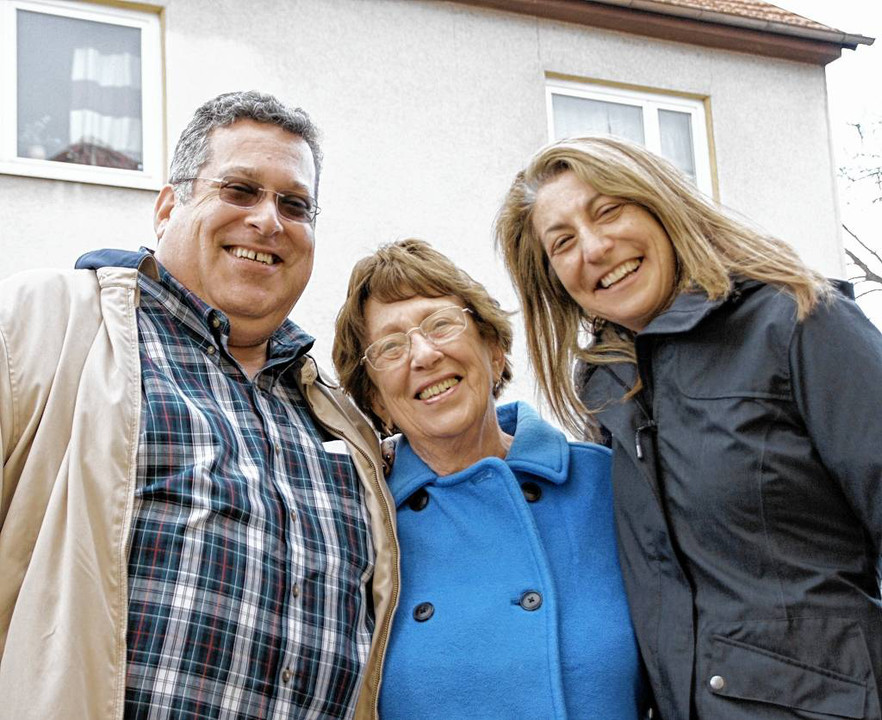
SONDHEIM/RHÖN
November 11, 2015 5:45 pm
By Steffen Standke
The house on the corner of Nordheimer/Bad Neustädter Straße offers nothing special: a dirty white facade, a red roof, a yellow mailbox. You can’t tell that it’s more than 120 years old. Nor does it show that until 1934 the only inhabitants of Jewish faith in the village lived there – the ancestors of Hanna Karlsruher. The 80-year-old fled from the Nazis as a child. Now she saw her great-grandparents’ house for the first time.
The house on the corner of Nordheimer Strasse and Bad Neustädter Strasse is nothing special: a dirty white facade, a red roof, a yellow mailbox. You can’t tell that it’s more than 120 years old. Nor does it show that until 1934 the only inhabitants of Jewish faith in the village lived there – the ancestors of Hanna Karlsruher. The 80-year-old fled from the Nazis as a child. Now she has seen her great-grandparents’ house for the first time.Fate has been kind to Hanna Karlsruher, née Plaut. Otherwise she would not be standing here in the middle of Sondheim. In August 1941, as a five-year-old Jewish girl, she was on one of the last trains to leave Berlin for Lisbon. According to her own account, she made it onto the last ship that left Portugal’s capital for New York at that time. Today she lives near Boston, Massachusetts.The extermination of some six million European Jews, the Holocaust, had long since begun. Unlike Hanna, some of her relatives did not survive it.Her family’s genealogical tree put down firm roots in Oberwaldbehrungen, especially in the 19th century. Many of her ancestors were born, lived and died there.
Later, outriggers grew to Sondheim, but also to Themar in Thuringia, 50 kilometers away. This is what Elisabeth Böhrer and the Canadian historian Sharon Meen found out. Karlsruhe’s great-grandparents Samuel and Philippine Schloß, for example, had been running a cut and colonial goods store in Sondheim since 1890 – in the house in front of which their great-granddaughter was now standing.
Hanna Karola Plaut – her full birth name – never established a relationship with Rhöndorf. She was born in Meiningen in 1935, grew up with her parents Elli Bär and Artur Plaut in Themar. “I don’t remember ever being in Sondheim.”
Why not. Her great-grandparents gave up the business before she was born and moved to Themar in mid-July 1934. Their daughter Selma – Hanna’s grandmother – already lived there. She had been born in Oberwaldbehrungen in 1888 and grew up in Sondheim. There she married her husband Emil Bär in 1910 and moved to Themar. The latter died already in 1913.
Hanna Karlsruher hardly knew her great-grandparents. Philippine Schloß died a few weeks after her birth in 1935, her husband Samuel in 1939. After his death Artur and Elli Plaut, daughter Hanna and grandma Selma moved to Berlin. From there, the family managed to escape at the end of August, as described. Except for Selma. She did not receive an exit permit. Her trail was lost in the Riga ghetto in January 1942.
At the turn of the 19th and 20th centuries, three more of Selma’s siblings grew up in Sondheim – Rosa, Minna and Julius – Hanna’s great uncles and aunts. Julius Schloß was killed in World War I; his name is immortalized on a war memorial in the Sondheim cemetery. Minna managed to escape from the Nazis to England with her husband in 1939. Rosa Schloß, however, was murdered in the Treblinka extermination camp in October 1942.
The house in Sondheim, the family tree, the graves of the ancestors – Hanna Karlsruher can do little with them. No wonder, her childhood and escape were three quarters of a century ago. “I feel like an American,” she says. The fact that she does so in almost accent-free German is due to her paternal grandmother. She never really learned English, preferring to speak German.
German was frowned upon in the wartime USA. Hanna Karola called herself “Carol” in the future. Thus, her origin from “enemy territory” remained rather in the dark.
Her parents hardly spoke about the time in Germany and the relatives. What had happened, had happened – and was over. They were Americans now. It wasn’t until years later that son Stuart opened a suitcase containing, among other things, old pictures and a doll from the old country. It had been lying on a cupboard.
That Hanna Karlsruher knows something about the expulsion and extermination of the Jews, she owes to her great-aunt Minna. She only got to know her properly after the war.
In the 1980s, Karlsruher and her husband traveled to Germany again for the first time; in 1990, she visited Themar with her children Stuart and Diane. And now the previously unknown house of the great-grandparents.
